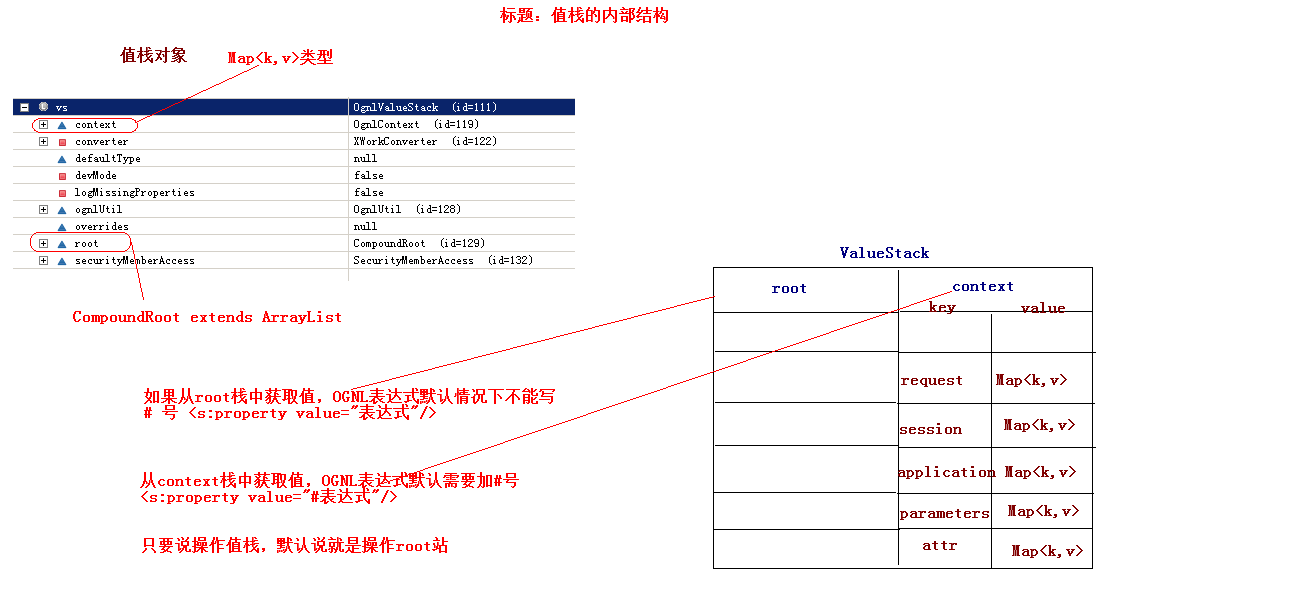structs2---OGNL表达式
技术分析之OGNL表达式概述(了解)
1. OGNL是Object Graphic Navigation Language(对象图导航语言)的缩写
* 所谓对象图,即以任意一个对象为根,通过OGNL可以访问与这个对象关联的其它对象
* 通过它简单一致的表达式语法,可以存取对象的任意属性,调用对象的方法,遍历整个对象的结构图,实现字段类型转化等功能。它使用相同的表达式去存取对象的属性 2. Struts2框架使用OGNL作为默认的表达式语言
* OGNL是一种比EL强大很多倍的语言
* xwork提供 OGNL表达式
* ognl-3.0.5.jar 3. OGNL 提供五大类功能
* 支持对象方法调用
* 支持类静态的方法调用和值访问
* 访问OGNL上下文(OGNL context)和ActionContext
* 支持赋值操作和表达式串联
* 操作集合对象 4. 测试的代码
// 访问对象的方法
@Test
public void run1() throws OgnlException{
OgnlContext context = new OgnlContext();
// 获取对象的方法
Object obj = Ognl.getValue("'helloworld'.length()", context, context.getRoot());
System.out.println(obj);
} // 获取OGNL上下文件的对象
@Test
public void run3() throws OgnlException{
OgnlContext context = new OgnlContext();
context.put("name", "美美");
// 获取对象的方法
Object obj = Ognl.getValue("#name", context, context.getRoot());
System.out.println(obj);
} // 从root栈获取值
@Test
public void demo3() throws OgnlException{
OgnlContext context = new OgnlContext();
Customer c = new Customer();
c.setCust_name("haha");
context.setRoot(c);
String name = (String) Ognl.getValue("cust_name", context, context.getRoot());
System.out.println(name);
}
技术分析之在Struts2框架中使用OGNL表达式
1. Struts2引入了OGNL表达式,主要是在JSP页面中获取值栈中的值
2. 具体在Struts2中怎么使用呢?如下步骤
* 需要先引入Struts2的标签库
> <%@ taglib prefix="s" uri="/struts-tags" %> * 使用Struts2提供的标签中的标签
> <s:property value="OGNL表达式"/> 3. 在JSP页面使用OGNL表达式
* 访问对象方法
<s:property value="'hello'.length()"/>
技术分析之值栈的概述
1. 问题一:什么是值栈?
* 值栈就相当于Struts2框架的数据的中转站,向值栈存入一些数据。从值栈中获取到数据。
* ValueStack 是 struts2 提供一个接口,实现类 OgnlValueStack ---- 值栈对象 (OGNL是从值栈中获取数据的 )
* Action是多例的,有一起请求,创建Action实例,创建一个ActionContext对象,代表的是Action的上下文对象,还会创建一个ValueStack对象。
* 每个Action实例都有一个ValueStack对象 (一个请求 对应 一个ValueStack对象 )
* 在其中保存当前Action 对象和其他相关对象
* Struts 框架把 ValueStack 对象保存在名为 “struts.valueStack” 的请求属性中,request中 (值栈对象 是 request一个属性)
* ValueStack vs = (ValueStack)request.getAttribute("struts.valueStack");
技术分析之值栈的内部结构
2. 问题二 : 值栈的内部结构 ?
* 值栈由两部分组成
> root -- Struts把动作和相关对象压入 ObjectStack 中--List
> context -- Struts把各种各样的映射关系(一些 Map 类型的对象) 压入 ContextMap 中 * Struts会默认把下面这些映射压入ContextMap(context)中
* 注意:request代表的是Map集合的key值,value的值其实也是一个Map集合。 > parameters: 该 Map 中包含当前请求的请求参数 ?name=xxx&password=123
> request: 该 Map 中包含当前 request 对象中的所有属性
> session: 该 Map 中包含当前 session 对象中的所有属性
> application:该 Map 中包含当前 application 对象中的所有属性
> attr: 该 Map 按如下顺序来检索某个属性: request, session, application * ValueStack中 存在root属性 (CompoundRoot) 、 context 属性 (OgnlContext )
> CompoundRoot 就是ArrayList
> OgnlContext 就是 Map * context 对应Map 引入 root对象
> context中还存在 request、 session、application、 attr、 parameters 对象引用
> OGNL表达式访问值栈中的数据
* 访问root中数据时 不需要 #
* 访问 request、 session、application、 attr、 parameters 对象数据 必须写 # > 操作值栈 默认指 操作 root 元素

技术分析之值栈的创建和ActionContext对象的关系
3. 问题三 : 值栈对象的创建,ValueStack 和 ActionContext 是什么关系?
* 值栈对象是请求时创建的
* ActionContext是绑定到当前的线程上,那么在每个拦截器或者Action中获取到的ActionContext是同一个。
* ActionContext中存在一个Map集合,该Map集合和ValueStack的context是同一个地址。
* ActionContext中可以获取到ValueStack的引用,以后再开发,使用ActionContext来获取到值栈对象
技术分析之获取到值栈的对象
4. 问题四 : 如何获得值栈对象
* 获得值栈对象 有三种方法
* ValueStack vs1 = (ValueStack) ServletActionContext.getRequest().getAttribute("struts.valueStack");
* ValueStack vs2 = (ValueStack) ServletActionContext.getRequest().getAttribute(ServletActionContext.STRUTS_VALUESTACK_KEY);
* ValueStack vs3 = ActionContext.getContext().getValueStack();
技术分析之向值栈中保存数据
5. 问题五: 向值栈保存数据 (主要针对root栈)
> valueStack.push(Object obj);
* push方法的底层调用root对象的push方法(把元素添加到0位置) > valueStack.set(String key, Object obj);
* 源码获取map集合(map有可能是已经存在的,有可能是新创建的),把map集合push到栈顶,再把数据存入到map集合中。 > 在jsp中 通过 <s:debug /> 查看值栈的内容
技术分析之从值栈中获取值
6. 问题六: 在JSP中获取值栈的数据
* 总结几个小问题:
> 访问root中数据 不需要#
> 访问context其它对象数据 加 #
> 如果向root中存入对象的话,优先使用push方法。
> 如果向root中存入集合的话,优先要使用set方法。 * 在OgnlContext中获取数据
> 在Action中向域对象中存入值
> request:<s:property value="#request.username"/>
> session:<s:property value="#session.username"/>
> application:<s:property value="#application.username"/>
> attr:<s:property value="#attr.username"/>
> parameters:<s:property value="#parameters.cid"/> 6.1 代码如下
<!--
// vs.push("美美");
// 获取到栈顶的值
<s:property value="[0].top"/>
--> <!--
// 栈顶是map集合,通过key获取值
vs.set("msg", "小凤");
<s:property value="[0].top.msg"/>
--> <!--
vs.push(user);
// 栈顶放user对象
<s:property value="[0].top.username"/>
<s:property value="[0].top.password"/>
// [0].top 关键字是可以省略的 findValue()
<s:property value="username"/>
--> <!--
vs.set("user", user);
<s:property value="[0].top.user.username"/>
<s:property value="[0].top.user.password"/>
// 省略关键字
<s:property value="user.username"/>
--> <!--
// 在ValueStack1Action提供了成员的属性
private User user = new User("小泽","456");
public User getUser() {
return user;
}
public void setUser(User user) {
this.user = user;
} User user = new User("小苍","123");
vs.set("user", user);
// 从栈顶开始查找,找user的属性,显示名称 返回的小苍
<s:property value="user.username"/> // [1].top获取ValueStack1Action [1].top.user返回user对象 [1].top.user.username获取对象的属性名称
<s:property value="[1].top.user.username"/>
--> <!--
栈顶是list集合
vs.push(ulist);
<s:property value="[0].top[0].username"/>
<s:property value="[0].top[1].username"/>
--> <!--
vs.set("ulist", ulist);
<s:property value="ulist[0].username"/>
--> <!-- 迭代的标签
属性
* value 要迭代的集合,需要从值栈中获取
* var 迭代过程中,遍历的对象
* var编写上,把迭代产生的对象默认压入到context栈中,从context栈取值,加#号
* var不编写,默认把迭代产生的对象压入到root栈中 for(User user:ulist){}
// 编写var的属性
<s:iterator value="ulist" var="u">
<s:property value="#u.username"/>
<s:property value="#u.password"/>
</s:iterator> // 没有编写var关键字
<s:iterator value="ulist">
<s:property value="username"/>
<s:property value="password"/>
</s:iterator>
--> <!-- 从context栈中获取值,加#号 HttpServletRequest request = ServletActionContext.getRequest();
request.setAttribute("msg", "美美");
request.getSession().setAttribute("msg", "小风"); <s:property value="#request.msg"/>
<s:property value="#session.msg"/>
<s:property value="#parameters.id"/>
<s:property value="#attr.msg"/>
--> <!-- 在JSP页面上,查看值栈的内部结构 -->
<s:debug></s:debug>
技术分析之EL表达式也会获取到值栈中的数据
7. 问题七:为什么EL也能访问值栈中的数据?
* StrutsPreparedAndExecuteFilter的doFilter代码中 request = prepare.wrapRequest(request);
> 对Request对象进行了包装 ,StrutsRequestWrapper
> 增强了request的 getAttribute
Object attribute = super.getAttribute(s);
if (attribute == null) {
attribute = stack.findValue(s);
}
> 访问request范围的数据时,如果数据找不到,去值栈中找
> request对象 具备访问值栈数据的能力 (查找root的数据)
总结OGNL表达式的特殊的符号
1. # 符号的用法
* 获得contextMap中的数据
> <s:property value="#request.name"/>
> <s:property value="#session.name"/>
> <s:property value="#application.name"/>
> <s:property value="#attr.name"/>
> <s:property value="#parameters.id"/>
> <s:property value="#parameters.name"/> * 构建一个map集合
* 例如:
* <s:radio name="sex" list="{'男','女'}"></s:radio>
* <s:radio name="sex" list="#{'0':'男','1':'女'}"></s:radio> 2. % 符号的用法
* 强制字符串解析成OGNL表达式。
> 例如:在request域中存入值,然后在文本框(<s:textfield>)中取值,现在到value上。
> <s:textfield value="%{#request.msg}"/> * { }中值用''引起来,此时不再是ognl表达式,而是普通的字符串
> 例如:<s:property value="%{'#request.msg'}"/> 3. $ 符号的用法
* 在配置文件中可以使用OGNL表达式,例如:文件下载的配置文件。
<action name="download1" class="cn.itcast.demo2.DownloadAction">
<result name="success" type="stream">
<param name="contentType">${contentType}</param>
<param name="contentDisposition">attachment;filename=${downFilename}</param>
</result>
</action>
structs2---OGNL表达式的更多相关文章
- Ognl表达式基本原理和使用方法
Ognl表达式基本原理和使用方法 1.Ognl表达式语言 1.1.概述 OGNL表达式 OGNL是Object Graphic Navigation Language(对象图导航语言)的缩写,他是一个 ...
- Struts2深入学习:OGNL表达式原理
今天看了ognl表达式,不是很理解,准备以后再回头复习: http://developer.51cto.com/art/201203/322509.htm#case1
- Struts2的OGNL表达式语言
一.OGNL的概念 OGNL是Object-Graph Navigation Language的缩写,全称为对象图导航语言,是一种功能强大的表达式语言,它通过简单一致的语法,可以任意存取对象的属性或者 ...
- struts2学习笔记--OGNL表达式1
struts2标签库主要使用的是OGNL语言,类似于El表达式,但是强大得多,它是一种操作对象属性的表达式语言,OGNL有自己的优点: 能够访问对象的方法,如list.size(); 能够访问静态属性 ...
- struts2 OGNL表达式
一.OGNL OGNL是Object-Graph Navigation Language的缩写,全称为对象图导航语言,是一种功能强大的表达式语言,它通过简单一致的语法,可以任意存取对象的属性或者调用对 ...
- OGNL表达式
一.什么是OGNL,有什么特点? OGNL(Object-Graph Navigation Language),大概可以理解为:对象图形化导航语言.是一种可以方便地操作对象属性的开源表达式语言 ...
- OGNL表达式(待解答)
OGNL表达式的路径到底怎样的?下面代码看不懂为什么要这样?
- OGNL表达式struts2标签“%,#,$”
一.什么是OGNL,有什么特点? OGNL(Object-Graph Navigation Language),大概可以理解为:对象图形化导航语言.是一种可以方便地操作对象属性的开源表达式语言.OGN ...
- JSTL标签,EL表达式,OGNL表达式,struts2标签 汇总
一下纯属个人总结摘抄,总结一起方便查看,解决疑问,有遗漏或错误,还请指出. 1,JSTL标签总结: a).JSTL标签有什么用? JSTL是由JCP(Java Commu ...
- Struts2的标签库(二)——OGNL表达式
Struts2的标签库(二) --OGNL表达式 1.Struts2中的OGNL表达式增加了ValueStack的支持. 注:ValueStack--实际上是一个容器对象,该对象在启动Struts2框 ...
随机推荐
- Please install Android target
今天在执行ionic build android时出现以下错误: [Error: Please install Android target: "android-22". Hint ...
- c的详细学习(5)数组
到目前为止,前面介绍的都是属于基本类型的数据.除此之外,C语言还提供了一些更为复杂的数据类型,称为构造类型.数组就是最基本的构造类型.若要针对一批数据进行某种操作,采用数组是一种方便可行的方法 ...
- apache中配置php支持模块模式、cgi模式和fastcgi模式的实验
首先安装apache.mysql和php,依次顺序安装. 1.apache.mysql的安装比较简单,略过 2. php的安装,我安装的是php5.3.6内置了php-fpm,所以不需要再单独下补丁了 ...
- Python 注释和中文乱码
Python 注释分为三种: 1.单行注释:# 2.多行注释:前后3个单引号,或者三个双引号: 如:''' 多行注释 ''', """或者 多行注释 '"&qu ...
- Spring Cloud之Swagger2 API接口管理
随着微服务架构体系的发展和应用, 为了前后端能够更好的集成与对接,同时为了项目的方便交付,每个项目都需要提供相应的API文档. 来源:PC端.微信端.H5端.移动端(安卓和IOS端) 传统的API文档 ...
- Spring Cloud之Feign客户端调用工具
feign介绍 Feign客户端是一个web声明式http远程调用工具,提供了接口和注解方式进行调用. Spring Cloud 支持 RestTemplate Fetin Feign客户端实际开发 ...
- 51nod 1681
题目 神犇题解 这题挺神的..思路很巧妙 首先想到DFS序(毕竟是子树问题),这道题可以转化成:我们对于每一个节点的子树区间去看,两棵树同一节点的这个子树区间有多少个相同元素,设个数为x,那么这个点的 ...
- java语法糖---枚举
java语法糖---枚举 在JDK5.0中提供了大量的语法糖,例如:自动装箱拆箱.增强for循环.枚举.泛型等.所谓“语法糖”就是指提供更便利的语法供程序员使用,只是在编译器上做了手脚,却没有提供 ...
- KbmMemTable的简单应用(增删改查示例)
//kbmMemTable unit Unit1; interface uses Windows, Messages, SysUtils, Variants, Classes, Graph ...
- Linux下开放防火墙端口
方法一:1.vi /etc/sysconfig/iptables 2.-A INPUT -m state --state NEW -m tcp -p tcp --dport 8080 -j ACCEP ...
